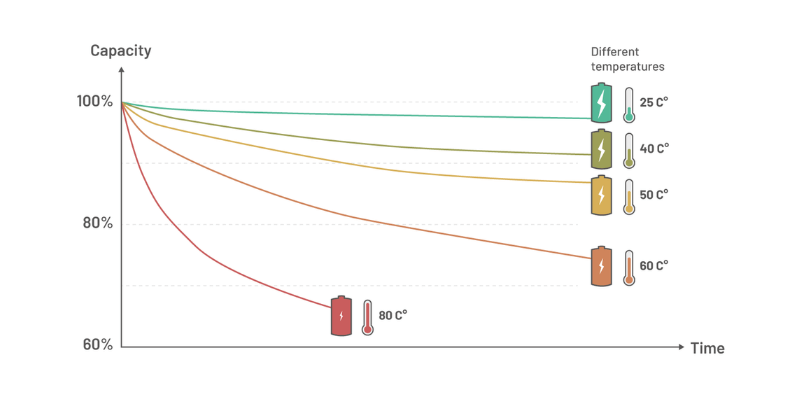Pochopenie životnosti batérie s hlbokým cyklom je rozhodujúce, či už je starý alebo nový. Rôzne faktory ovplyvňujú jeho životný cyklus, ale najprv definujeme, čo je cyklus výdrže batérie a ako ho vypočítať.
Čo je to cyklus výdrže batérie?
Keď sa používa batéria a nabíjajú sa, postupne stráca svoju pôvodnú kapacitu. Jeho životný cyklus sa vzťahuje na počet cyklov náboja a výboja, ktoré môžu dokončiť pred poklesom výkonu.
Ako vypočítať cyklus výdrže batérie?
Po prvom použití sa batéria nemusí nabíjať na plnú kapacitu, ale to nenaznačuje jej koniec života.
Výrobcovia zvyčajne poskytnú údaje o prijateľnom výkone a znížení kapacity pred koncom životného cyklu batérie.
Aj keď neexistuje štandard, všeobecné pravidlo je, že životný cyklus batérie sa meria počtom cyklov, ktoré sa môže podrobiť pred nabíjaním na menej ako 80% svojej pôvodnej kapacity.
Ako sa určuje hĺbka výtoku?
Kapacita batérie sa dá pochopiť aj cez hĺbka výboja (DOD), ktorý meria percento kapacity batérie použitej v porovnaní s jej celkovým počtom.
Napríklad nová batéria 100 AH vypustená na 20 minút pri prúdení 50 A má pre tento cyklus 16,7 % (50*20/10/16) DOD.
Ako už bolo spomenuté, limit životného cyklu sa dosiahne, ak sa batéria nemožno nabíjať nad 80 ah, čo vedie k začiatku 20% DOD aj v “plné” poplatok.
Môžete použiť monitor ako Victron BMV-700 Presne sledovať DoD.

Koľko cyklov dostane batéria?
Životný cyklus batérie závisí od jej typu a použitia.
Cyklus výdrže batérie lítium-iónov
Väčšina li-iónových batérií trvá asi 500 cyklov, zatiaľ čo batérie LifePo4 môžu vydržať tisíce cyklov pred poklesom kapacity.
V holo batérii, naša Prispôsobené riešenia LIFEPO4 Majte hodnotenie životného cyklu 3 000-5 000 cyklov pri ťažkom používaní a ešte vyššie s použitím svetla.
Normálne výrobcovia špecifikujú hĺbku limitu výboja na dosiahnutie týchto ratingov.
Lítium-iónové batérie sú menej ovplyvnené faktormi environmentálnych a výbojov ako faktory olova, čo vedie k presnejším odhadom životného cyklu.
Cyklus výdrže batérie olovo
Valcová batéria môže trvať až 1 500 cyklov so správnou údržbou, najmä ak sa uchováva nad 50% nábojom.
Jeho dlhovekosť však závisí od výtoku svetla a správnych cyklov nabíjania. Nájdenia silných energie alebo hlboké výboje výrazne znížia počet cyklov.
V priemere trvá 300-500 cyklov.

Čo znižuje nabíjateľnú výdrž batérie?
Niekoľko faktorov, okrem typu batérie, ovplyvňuje jeho životný cyklus. Pochopenie ich môže pomôcť maximalizovať výkon a dlhovekosť.
Teplota
Teplota významne ovplyvňuje výdrž batérie a často spôsobuje zmätok.
Zatiaľ čo vyššie teploty môžu zvýšiť výkon, v skutočnosti znižujú životnosť batérie, najmä v batériách s olovom. Optimálna teplota pre batérie je okolo 25 ° C (77 ° F).
Jedna štúdia zistila, že výkon lítium batérie klesol asi o 3. 3% pri 77 ° F a 6,7% pri 113 ° F počas prvých 200 cyklov. Pokiaľ ide o olovené batérie, polovice životnosti s každým 15-stupňovým zvýšením nad 77 ° F.

Nadmerná hĺbka výtoku
Hĺbka výboja tiež ovplyvňuje výdrž batérie.
V prípade batérií olovených kyselín môže cyklistika na 50% DOD namiesto 80% zdvojnásobiť životnosť, zatiaľ čo cyklistika na 10% DOD ju môže päťnásobne zvýšiť. Najlepšie je nevypúšťať pod 50%.
Lítiové batérie sú menej ovplyvnené hlbokými výbojmi, ale odporúča sa, aby sa neposkytlo pod 80% DOD.
Nedostatočný cyklus nabíjania
Úplne nabíjanie batérie je dôležité. Dokončenie cyklu nabíjania umožňuje fázu kondicionovania, ktorá znižuje sulfatáciu na doskách olovených doštičiek.
Aj keď neúplné náboje ovplyvňujú lítiové batérie menej v dôsledku ich interného systému monitorovania batérií (BMS), stále je najlepšie ich úplne nabíjať, ak je to možné.
Strata elektrolytov
Batérie s hlbokým cyklom obsahujú elektrolyt pre vnútorné reakcie.
V zaplavených batériách s olovom, odparovanie môže nechať elektrolyt za sebou. Zanedbanie pravidelného doplňovania týchto batérií výrazne zníži ich životnosť.
Lítium a zapečatené olovo-kyslé batérie majú tiež elektrolyty. Sú však zapečatené a eliminujú potrebu náplne.
Avšak zapečatené batérie olovo-kyseliny môžu počas rýchleho nabíjania alebo nadmerného nabíjania mimo plynu, čo vedie k drobnej strate elektrolytov, ktoré môžu v priebehu času ovplyvniť životnosť cyklu.
Kryštalizácia elektród
Všetky batérie sa časom degradujú v dôsledku chemických zmien.
Vklady sa tvoria na elektródach, ako sú napríklad kryštály síranu olova v batériách olovených a kovovými lítiami v lítium-iónových batériách. Tieto zmeny znižujú dostupné chemikálie na reakcie, zvyšujú vnútorný odpor a v konečnom dôsledku môžu viesť k zlyhaniu batérie, ak sú nadmerné.

Ako zvýšiť výdrž batérie?
Pochopenie faktorov ovplyvňujúcich životný cyklus vašej batérie vám môže pomôcť predĺžiť jeho životnosť. Podľa jednoduchých osvedčených postupov môže maximalizovať výkon pre batérie kyseliny olova aj lítium-iónov.
- Ak je to možné, použite batériu v miernych teplotách, v ideálnom prípade okolo 77 ° F.
- V prípade batérií na olovom kyseline sa vyhnite vypúšťaniu pod 50% kapacity; Cieľom na hĺbku vypúšťania 10% až 50%. Línové batérie zvyčajne zvládajú hĺbku výboja do 80% a niekedy dokonca 100%.
- V prípade zaplavených batérií olovených kyselín udržujte roztok elektrolytu zakončené.
- Nakoniec nabite batériu pomaly, aby ste znížili vnútorný odpor a predĺžili jej životnosť.

